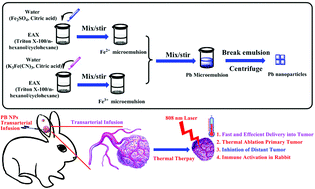NIR-absorbing Prussian blue nanoparticles for transarterial infusion photothermal therapy of VX2 tumors implanted in rabbits†
Abstract
Nanomaterial-related photothermal therapy has been intensively investigated for treatment of hepatocellular carcinoma (HCC). However, owing to the low specificity to tumors and easy excretion from the systemic circulation, the low dose of photoactive nanomaterials in solid tumors severely hinders the photothermal therapy applications for HCC. Herein, an innovative strategy for transarterial infusion photothermal therapy (TAIPPT) of VX2 tumors implanted in rabbits is reported. NIR-absorbing Prussian blue nanoparticles were prepared by microemulsion methods, which demonstrate excellent photothermal therapy capacity and satisfactory biocompatibility. Prussian blue nanoparticles are transarterially infused into VX2 tumors and irradiated for photothermal therapy. TAIPPT achieves fast and efficient delivery of nanoparticles into tumors and complete ablation by one-time transarterial infusion treatment. Furthermore, TAIPPT could activate the immune cells in rabbits and inhibit distant tumors. Our findings describe a promising strategy for tumor eradication and may benefit future clinical HCC patients.

- This article is part of the themed collection: 2021 Nanoscale HOT Article Collection


 Please wait while we load your content...
Please wait while we load your content...